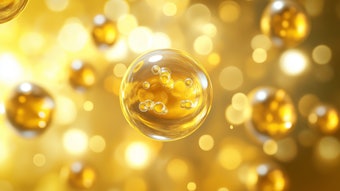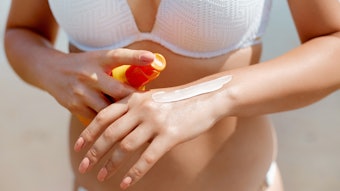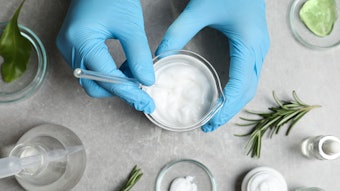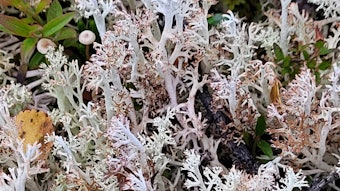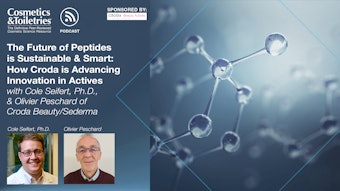Pigmentation of the skin because of synthesis and dispersion of melanin in the epidermis has a great significance in the cosmetic industry and society in general. It is the key physiological defense against sun-induced damages such as sunburn, photoaging and photocarcinogenesis. Human skin color varies around the world. It ranges from a very dark brown in some African, Australian and Asian-Indian skin to a near pinkish-yellow among some northwest Europeans. Complexion coloration in humans primarily is regulated by the amount and type of melanin synthesized by the epidermal melanocyte.1,2 Melanocytes have specialized organelles termed melanosomes that contain several enzymes such as tyrosinase, tyrosinase-related protein-1 and tyrosinase-related protein-2, which catalyze the production of melanin.
Tyrosinase is the first and a rate-limiting step in melanogenesis.3 However, additional and equally contributing factors consist of efficient transfer of melanin from melanocytes to the neighboring keratinocytes and distribution and degradation of the transferred melanosomes by the recipient keratinocytes. The protease-activated receptor-2 (PAR-2) and unidentified surface lectins and glycoproteins facilitate this transfer process.4,5 Skin-lightening agents (melanogenesis inhibitors) have been used widely to either lighten or even-toning the skin.6,7 Preparations in the European market are often used to treat age spots and freckles or to obtain even-toning effects, whereas the Asian market uses them to change or modify skin color.
Phyllanthus emblica
Phyllanthus emblica (P. emblica) has been used for more than 4,000 years for a variety of human ailments in ayurveda.8 Its status ranges from insignificant in the western world to highly prized in tropical Asia. The antioxidant fraction of P. emblica (Syn. Emblica officinalis) fruitsa, used in this investigation and referred to in the text as P. emblica, is different from other commercially available extracts of P. emblica fruits. This is because it contains more than 50%, typically 65–75%, of key chemical components—low molecular-weight ( <1,000) hydrolyzable tannins.
Previously, studies reported cascading antioxidant activity,9 chelating activity,10 antioxidant and matrix metalloprotease inhibitory activity11,12 of a standardized extract of P. emblica fruit. No report has yet shown the melanin inhibitory activity of the low molecular-weight hydrolyzable tannins found in P. emblica; the goal of the present work is to investigate its effectiveness as a melanin inhibitor (in vitro and in vivo), to define its mode of melanin inhibitory activity, and to show its applicability as a cosmetic ingredient to lighten and even-tone normal and hyperpigmented skin color.
Materials
Skin lightening agents, enzymes and reagents were obtained for comparison. Skin lightening agents included:
P. emblica, hydroquinone, kojic acid, magnesium ascorbyl phosphate >95% pureb, Glycyrrhiza glabra (licorice) root extractc and ascorbyl-2-O-β-D-Glucosided.
Enzymes and reagents studied were: mushroom tyrosinase and horseradish peroxidase, potassium diphosphate, disodium EDTA, potassium hydroxide, L-DOPA, L-tyrosine, hydrogen peroxide and FeCl2. Human melanocytes from moderately pigmented donor and human keratinocytes also were purchased.
Methods
In vitro melanin inhibitory activity: Keratinocyte and melanocyte co-cultures were selected for this study. They were used at a 1:3 ratio in the fully supplemented 254 mediumg in 6 well plates, at 30,000/96,000 cells/well. Cells were grown for 4 days for the pilot experiment and for 11 days for the subsequent tests with 2 growth medium changes. At the end of these tests, cells were counted and lysed with cellytic mammalian cell lysis/extraction reagent. Melanin content was determined spectrophotometrically at 405 nm. Cell cultures were monitored using an inverted microscope.
In vivo skin lightening study (normal skin): Healthy male and female subjects were used for the study. Subjects having history of sensitivity to facial skin care products, visible skin disease, or who were pregnant or lactating were excluded from the study. The study was conducted comparing baseline (pretreatment) to final (posttreatment) results of the upper left and right arms. For 9 weeks, each subject was given two products incorporating identical formulation ingredients, one with P. emblica (Formula 1) for the upper left arm and the other one with a different material (Formula 2) as a positive control for the right upper arm.
The panelists were instructed to apply approximately 0.5mL of the test materials twice daily. The selected test application sites were photographed before the study and after 3, 6 and 9 weeks of treatment. In order to determine the effect of the base formulation, if any, an additional study was conducted comparing the results of the product with P. emblica vs. a placebo without P. emblica. The subjects were instructed to record the date and time of each use of the test materials and asked to refrain from excessive sun exposure during the course of the study.
Rigid control of photographic technique, from the aspects of lighting, distance, angles and camera/film settings and specifications, and subsequent development of photographs were followed. Skin color measurements were performed using a tristimulus instrumentd. Three consecutive readings of the test site were taken and the mean was used as the data point. The Repeated Measures Analysis of Variance and t-Test (dependant) were performed via computer.e
ITA measurement: The measurement procedure for determining Individual Typology Angle (ITA) was performed in L* a* b* mode following the European Expert Group on Efficacy Measurement of Cosmetics and Other Topical Products (EEMCO) recommendations.13 ITA value is calculated from the mean L* and b* colorimetric values13, 14 using the formula:
Eq. 1
ITA Degree =
[Arc Tangent ((L* - 50)/b*)] 180/3.1416
Where L* value is the lightness value, a* is the color value in the red-green axis, and b* is the color value in the blue-yellow axis. The higher ITA degree indicates the lightening of the skin. ∆E of ITA degree was calculated by subtracting the average ITA degree of the treated site from that of the average baseline (day 1 of the study). Statistical significance of the data was determined by student t-Test.
Six separate clinical studies were performed to determine the potential of P. emblica as a skin lightener:
• Study 1: Comparison of 2% P. emblica vs. 2% hydroquinone (13 Asians);
• Study 2: Comparison of 2% P. emblica vs. 2% hydroquinone (13 Hispanics);
• Study 3: Comparison of 1% P. emblica vs. 3% magnesium ascorbyl phosphate (MAP, 16 Asians);
• Study 4: Comparison of 1% P. emblica vs. 2% kojic acid (16 African-Americans);
• Study 5: Comparison of 1% P. emblica vs. 0.1% Glycyrrhiza glabra (licorice) root extract (15 Hispanics); and
• Study 6: Comparison of 1% P. emblica vs. 3% ascorbyl glucoside (14 Hispanics).
Human volunteers with skin Types III and IV (as defined by the Fitzpatrick Photo-type Scale) were selected for all studies except study 4, in which skin types IV to VI were used.
In vivo skin lightening study (hyperpigmented skin): Healthy female subjects were used for the study. Subjects having history of sensitivity to facial skin care products, visible skin disease, or who were pregnant or lactating were excluded from the study. The study was conducted comparing baseline pretreatment to final posttreatment results of the selected test sites. The length of the study was 8 weeks. Each subject was given one lotion containing 1% P. emblica. The panelists, consisting of 19 Caucasian females with significant freckles, were instructed to apply the test material twice daily to the entire face. The selected test application site was photographed before the start of the study and then repeated after 4 and 8 weeks. Rigid control of photographic technique, as previously described, was followed. Skin color measurements were performed using a tristimulus instrumentf. Repeated Measures Analysis of Variance was used to determine if any significant differences were observed in the mean Individual Typology Angle (ITA degree). Statistical significance of the data was determined by student t-Test.
P. emblica Melanin Inhibitory Action
Tyrosinase + H2O2 with tyrosine or L-DOPA as substrate:15, 16 Tyrosinase catalyzes oxidation of tyrosine to L-DOPA, and also L-DOPA to DOPAchrome, in the presence of H2O2, ultimately to formation of melanin in human skin. A mixture of substrate—1 mL, 6.3 mM for L-DOPA or 1.3 mM for tyrosine; hydrogen peroxide, 1 mL, 5 mM; and phosphate buffer, 2 mL, pH 7.4—was incubated for 10 min at 25ºC. Then, 2 mL of this mixture was added to 1 mL containing 120 units of mushroom tyrosinase, the lightening ingredient and a buffer solution. After 15 min of reaction time, DOPAchrome was formed having a characteristic absorption band at 475 nm.
The spectra were recorded between 300–700 nm, and the optical density at 475 nm (due to DOPA-chrome) was measured.
Peroxidase + H2O2 with L-DOPA as a substrate:15, 16 This method is similar to that described above, except the enzyme used was horseradish peroxidase. Thus, a mixture of L-DOPA (1 mL, 6.3 mM), hydrogen peroxide (1 mL, 5 mM), and phosphate buffer (2 mL, pH 7.4) was incubated for 10 min at 25ºC. The remainder of the method was identical to that described above. Fe2+:EDTA + H2O2 with L-DOPA as a substrate:15, 16 Again, this method is similar to that previously described, except the enzyme is replaced with Fe2+EDTA. Thus, a mixture of L-DOPA (1 mL, 6.3 mM), hydrogen peroxide (1 mL, 5 mM) and phosphate buffer (2 mL, pH 7.4) was incubated for 10 min at 25°C. The remainder of the method was identical to that described previously.
In vitro Melanin Inhibitory Activity
The co-culture experiment was validated by microscopic observation, which revealed the presence of both keratinocytes and melanocytes. The 4-day pilot study showed a moderate (17%) reduction in melanin inhibitory activity of P. emblica at 50 µg/mL, and practically no activity at lower concentrations tested (10 and 20 µg/mL). Hydroquinone was found to be cyto-toxic at 5 µg/mL. The incubation time was prolonged in order to determine whether this results in a better melanin inhibitory activity. The result has been confirmed by additional studies, which showed that the inhibitory activity of P. emblica at 50 µg/mL is very similar to that of kojic acid (50 µg/mL). An 11-day incubation resulted in a 41–47% inhibition of melanin production, which were adjusted to cell numbers (Figure 1). The results have a direct correlation to the number of melanocytes present in the well. If the cell numbers after the completion of the study are not taken into account, results could be due to cytotoxicity and not due to melanin inhibitory activity.
In vivo Skin Lightening Activity: Normal Skin
Each comparative study consists of two products with identical formulation ingredients (one containing P. emblica and the other with a different material, positive control). No attempt was made to optimize these formulations. The results of these clinical studies are summarized in Figure 2.
The purpose of carrying out six clinical studies was to determine the skin lightening effect of P. emblica in comparison with well-known and well-documented skin lighteners. In all six studies, P. emblica-containing product showed a significant increase in ITA degree (meaning skin lightening)13,14 versus the corresponding baselines. Studies 1 and 2 clearly showed that 2% P. emblica has a comparable skin lightening effect to that of 2% hydroquinone in Asian as well as Hispanic subjects. Study 3 showed that 1% P. emblica was at least three times better in skin-
lightening efficacy on a percentage-active basis over the 3% MAP product. Studies 4 and 5 showed 1% P. emblica was comparable to 2% kojic acid and 3% ascorbyl glucoside, respectively. Study 6 showed 1% P. emblica was comparable to 0.1% Glycyrrhiza glabra (licorice) root extract (0.1%).
In vivo Skin Lightening Activity: Hyperpigmented Skin
P. emblica-containing product showed a significant increase in ITA degree13,14 and L value versus the corresponding baselines, especially after 8 weeks. After the 8 weeks of treatment, reduction in freckle spots was seen in 17 out of 19 subjects, which is statistically significant (p<0.005). The result of this clinical study is summarized in Figure 3.
Mechanism of Melanin Inhibitory Action of P. emblica
P. emblica has a unique mechanism of action because is acts at several different sites in the melanogenesis pathway. It inhibits two enzymatic pathways catalyzed by tyrosinase—tyrosine to L-DOPA and L-DOPA to DOPAchrome, and peroxidase/H2O2 DOPA to DOPAchrome activity. It also inhibits Fe2+/H2O2-induced melanogenesis by quenching Fe2+. Chelating activity of P. emblica has been previously reported.10 Based on the peroxidase inhibitory activity of P. emblica in the conversion of L-DOPA to DOPAchrome, it is quite conceivable to assume that P. emblica also can inhibit peroxidase/H2O2-induced conversion of dihydroxy indole (DHI) and dihydroxy indole carboxylic acid (DHIC) to melanin. Prota et al. demonstrated that peroxidase is much more effective than tyrosinase in calalyzing conversion of DHI and DHIC to melanin synthesis.17
It is reported16 that ultraviolet radiation (UVR) is able to act directly on cells to bring about delayed increases in melanogenesis. UVR also stimulates melanogenesis through a more rapid action that is not associated with an activation of tyrosinase. This effect could be mediated by the superoxide anion which, rather than activating tyrosinase, could act by serving as a substrate for the enzyme.18 Since P. emblica has a strong superoxide anion inhibitory activity,11, 12 it is quite reasonable to assume that it inhibits melanogenesis by quenching superoxide anion radical as well.19-21 All data suggests that melanin inhibitory activity of P. emblica is explained by inhibition of the major enzymes involved and also, inhibition of Fe2+/H2O2- and superoxide anion-induced melanogenesis. Figure 4 summarizes the mechanism of action of P. emblica.
Conclusion
Melanogenesis is the process of production and subsequent distribution of melanin by melanocytes and is controlled by many factors. Skin lighteners can inhibit tyrosinase activity or block the chain reaction at various points of the melanogenesis pathway. Tyrosinase inhibition is the key mode of action in most commercial skin lighteners. P. emblica was found to inhibit two enzymatic pathways catalyzed by tyrosinase and inhibit Fe2+/H2O2-induced melanogenesis by the chelation of Fe2+ and superoxide anion-induced melanogensis by quenching superoxide anion. It has been reported mistakenly that P. emblica works by inhibiting α-melanocyte stimulating hormone.22
P. emblica has been shown to be a safe22 and effective skin lightener as demonstrated by several clinical studies. Increasing use of skin-lightening agents among global population has made it apparent that both the efficacy of a skin lightening formulation, as well as safety and mildness of the skin lightening ingredient, are equally important. Many current skin lighteners such as hydroquinone23,24 and kojic acid25,26 have inadequate safety27 and stability profiles. The US Food and Drug administration (FDA) has recently proposed a ban on the sale of products containing hydroquinone.28 The proposed ban comes after mounting evidence linking the use of hydroquinone to potential health risks. The FDA is now describing hydroquinone as a possible carcinogen. Also, the FDA reports consumers have developed ochronosis after using hydroquinone products for as little as three months. Based on the toxicity problems of hydroquinone and kojic acid, it is quite reasonable to question the safety of arbutin (hydroquinone–β-D-glucoside) and kojic acid dipalmitate for human use. Recently, a case of contact dermatitis due to arbutin has been reported.29
P. emblica also was shown in a recent unpublished clinical study to reduce the appearance of wrinkles and fine lines. A properly constituted P. emblica, such as the one described and tested, could provide a great value as a photoprotective agent in combination with sunscreens and an antiaging and skin-lightening agent. The effects and skin care benefits of P. emblica make it an ideal choice for a variety of cosmetic products targeting young and matured skin alike.
References
1. S Ito, A chemist’s view of melanogenesis, Pigment Cell Res, 16 230–236 (2003)
2. B Kasraee, Peroxidase-mediated mechanisms are involved in the melanocytotoxic and melanogenesis-inhibiting effects of chemical agents, Dermatology, 205 329–339 (2002)
3. G Prota, Melanins, melanogenesis and melanocytes: Looking at their functional significance from the chemist’s viewpoint, Pigment Cell Res, 13 283–293 (2000)
4. I Minwala, Y Zhao, J Cornelius, GF Babcock, RR Wickett, IC Le Poole, RE Boissy, Inhibition of melanosome transfer from melanocyte to keratinocytes by lectins and neoglycoproteoins in an in vitro model system, Pigment Cell Res, 14 185–194 (2001)
5. RE Boissy, Melanosome transfer to and translocation in the keratinocytes, Exp Dermatol, 12S 5–12 (2003)
6. H Zhai, HI Maibach, Skin-whitening agent, Cosm & Toil, 116 20–25 (2001)
7. L Petit and GE Pierard, Skin-lightening products revisited, Int J Cosmet Sci, 25 169–181 (2003)
8. S Ghosal, VK Triphati, S Chauhan, Active constituents of Emblica officinalis: Part 1–The chemistry and antioxidative effects of two new hydrolysable tannins: Emblicanin A and B, Indian J. of Chem, 35B 941–948 (1996)
9. RK Chaudhuri, Emblica cascading antioxidant: A novel natural skin care ingredient, Skin Pharmacol Appl Skin Physiol, 15 374–380 (2002)
10. RK Chaudhuri, G Puccetti, Transition metal-induced oxidation: implications for skin care products, Cosm & Toil, 117 43–56 (2002)
11. RK Chaudhuri, C Hwang, G Puccetti, G Guttierez, M Serrar, Low molecular-weight tannins of Phyllanthus emblica: Anti-aging effects, Cosm & Toil, 119 59–68 (2004)
12. RK Chaudhuri, Anti-aging benefits of Phyllanthus emblica, Personal Care, 6 13–17 (2005)
13. GE Pierard, EEMCO guidance for the assessment of skin colour, J Eur Acad Dermatol Vernerol, 10 1–11 (1998)
14. A Chardon, I Cretois, C Hourseau, Skin colour typology and suntanning pathways, Int J Cosmet Sci, 10 1–11 (1998)
15. I Kubo, I Kinst-Hori, SK Chaudhuri, Y Kubo, Y Sanchez, T Ogura, Flavonols from Heterotheca inuloides: Tyrosinase Inhibitory Activity and Structural Criteria, Bioorganic & Medicinal Chem, 8 1749–1755 (2000)
16. C Blarzino, L Mosca, C Foppoli, R Coccia, C de Marco, MA Rosei, Lipoxygenase/H2O2 –catalyzed oxidation of dihydroxyindoles: Synthesis of melanin pigments and study of their antioxidant properties, Free Radical Biology & Medicine, 26 446–453 (1999)
17. M d’Ischia, A Napolitano, K Tsiakas, and G Prota, New Intermediates in the Oxidative Polymerization of 5,6-dihydroxyindole to Melanin promoted by the peroxidase/H2O2 system, Tetrahedron, 46 5789–5796 (1990)
18. D Tobin and AJ Thody, The superoxide anion may mediate short- but long-term effects of ultraviolet radiation on melanogenesis, Exp Dermatol, 3 99–105 (1994)
19. P Valverde, P Manning, C Todd, CJ McNeil and AJ Thody, Tyrosinase may protect human melanocytes from the cytotoxic effects of the superoxide anion, Exp Dermatol, 5 247–253 (1996)
20. JM Wood and KU Schallreuter, Studies on the reaction between human tyrosinase, superoxide anion, hydrogen peroxide and thiols, Biochim Biophys Acta: 1074 378–385 (1991)
21. RK Chaudhuri, Role of antioxidants in sun care products, in Sunscreens, Regulations and Commercial Development, N Shaath, ed., 3rd Edition (2005) pp 603–638.
22. RK Chaudhuri: Phyllanthus tannins, in Cosmeceuticals: Drugs versus Cosmetics, P Elsner and HI Maibach, eds., 2nd Edition, (2005) pp 465–488
23. CY Levin and H Maibach, Exogeneous ochronosis: An update on clinical features, causative agents and treatment options, Am J Clin Dermatol, 2 213–217 (2000)
24. AP DeCaprio, The toxicology of hydroquinone—relevance to occupational and environmental exposure, Crit Rev Toxicol, 29 283–330 (1999)
25. T Takizawa, K Mitsumor, T Tamura, M Nasu, M Ueda, T Imai and M Hirose, Hepatocellular tumor induction in heterozygous p53-deficienr CBA mice by a 26-week dietary administration of kojic acid, Toxicol Sci, 73 287–293 (2003)
26. T Tamura, K Mitsumori, H Onodera, N Fujimoto, K Yasuhara, K Takegawa, H Takgi and M Hirose, Dose-threshold for thyroid tumor-promoting effects of orally administered kojic acid in rats after initiation with N-bis(2-hydroxypropyl) nitrosoamine, J Toxicol Sci, 26 85–94 (2001)
27 R Chaudhuri, Unrealistic Claims—It’s time to get real and get safe about skin lightening, Soaps, Perfumery & Cosmetics, 16–17 (2005)
28. Federal Register, 71 51,146–51,155 (2006)
29. K Sugawara, H Kobaysahi, K Teramae, M Ishi, A Kato, A case of contact dermatitis due to arbutin, Environ Dermatol, 9 146–148 (2002)

